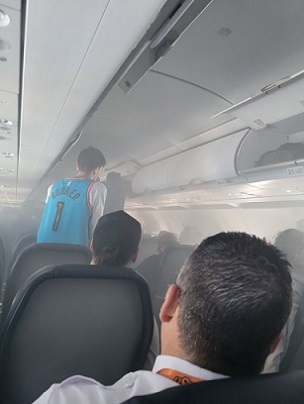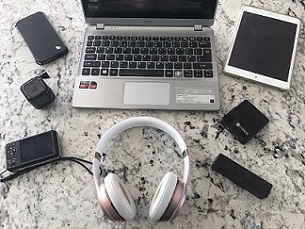 Smoke spirals through an aircraft passenger cabin during a lithium fire incident
Smoke spirals through an aircraft passenger cabin during a lithium fire incident
 All these personal electronic devices are powered by lithium batteries … but not a lot of people seem to know that
All these personal electronic devices are powered by lithium batteries … but not a lot of people seem to know that
 An AvSax lithium battery thermal fire mitigation bag
An AvSax lithium battery thermal fire mitigation bag
The number of lithium battery incidents on planes has increased by more than 25% yet passengers remain unaware of the dangers, according to a report.
The report by UL Standards & Engagement (ULSE) in the USA shows a 28% increase in battery thermal runaway incidents – a record high – on aircraft yet limited passenger awareness of the dangers of lithium-ion batteries while flying.
ULSE is a nonprofit organisation that translates safety science into action through setting standards and since 1903 has developed nearly 1,700 standards and guidance documents for products ranging from fire doors to autonomous vehicles.
When lithium batteries overheat or are damaged they go into thermal runaway and when this happens one cell in a battery overheats it can produce enough heat – up to 900°C (1652°F) – to cause adjacent cells to overheat.
The heat generated by chemical reactions inside the battery causes even more heat, leading to a continuous rise in temperature. This can result in the battery venting and releasing toxic flammable gases, exploding or catching fire and because they burn at such a high temperature they are very difficult to put out.
ULSE is for the first time publicly sharing data from its Thermal Runaway Incident Programme (TRIP), a voluntary lithium-ion battery incident reporting system, to clarify the problem and support ways to find solutions.
TRIP involves 35 passenger and cargo airlines and was designed with the aviation industry to better understand the extent of thermal runaway incidents caused by lithium-ion batteries on board aircraft and how to prepare for, or ideally prevent, future incidents.
David Wroth, director of technology and systems at ULSE and the leader of TRIP, said: “Passengers are often unaware that many devices they bring on board are powered by lithium-ion batteries let alone the risks they carry and it’s much harder to solve a problem they do not know exists.
“Thermal runaway incidents on board aircraft are largely preventable but admittedly more difficult to contend with at 40,000 feet. TRIP provides a unique opportunity for the aviation industry to come together to find strategies to mitigate the risk of these incidents.”
As technology evolves and more products rely on rechargeable power, lithium-ion batteries are getting more powerful and, in some cases, larger, further complicating the thermal runaway threat.
Damaged, substandard or counterfeit batteries run the greatest risk of going into thermal runway which could have catastrophic consequences in the confined space of an aircraft, especially at high altitude.
The report’s main 5 points are:
Lesley Rohrbaugh, head of insights and policy analysis for ULSE, said: “Our research highlights several trouble spots that need to be addressed from passengers missing warnings about lithium-ion batteries to packing rechargeable devices out of reach.
“But we also see clear opportunities to reduce the risk and that’s where we’re focused.”
The potential danger of lithium battery fires on aircraft is why more than 100 airline companies worldwide – including some of the biggest names in the industry – carry AvSax lithium battery fire mitigation bags which are now on board around 16,750 aircraft globally and have been deployed in action dozens of times.
AvSax were devised in the UK by Environmental Defence Systems Ltd based in Huddersfield, Yorkshire, England, and are the most widely deployed thermal fire containment bags in the airline industry.
For more on AvSax go to https://avsax.com/